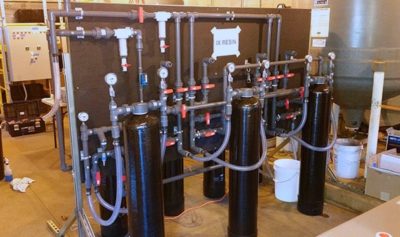Project highlights and product features
- Side-by-side PFAS removal testing of ECT2’s Sorbix A3F resin versus a typical carbon system was conducted at a New England air base
- The resin outperformed GAC on all PFAS compounds in the groundwater matrix, demonstrating 5 to 6 times the removal capacity for PFOA and more than 8 times the removal capacity for PFOS
- Sorbix capitalized on its dual mechanism of PFAS removal, serving as an adsorbent with ion exchange functionality, thereby taking full advantage of the unique properties of PFAS compounds to maximize treatment capacity and efficiency
- A favorable lifecycle cost evaluation led to the decision to move forward with a full-scale Sorbix resin system installation at the Site, scheduled to launch in Fall 2017.
- Superior PFAS removal capacity, on-site resin regeneration, and recovery/reuse of the spent regenerant solution all contribute to the financial, waste minimization, and sustainability advantages of Sorbix resin systems over GAC

ECT2 pilot tested its ion exchange resin technology (Sorbix A3F) side-by-side versus granular activated carbon from a typical system with GAC technology for six months at a former Air Force Base in New England (Site). Identical systems were designed for both resin and GAC to treat groundwater with total PFAS concentrations of approximately 100 μg/L in an existing, recently decommissioned chlorinated solvent treatment facility. The pilot test’s primary goal was to determine the best available PFAS treatment technology for reducing groundwater concentrations at the Site below USEPA health advisories (HAs) for PFOS and PFOA: 0.07 μg/L for both the individual constituents and the sum of PFOS and PFOA concentrations. The pilot study results would then be used to select the best PFAS treatment process for full-scale implementation at the Site.
Both GAC and resin pilot trains used vessels in series: four GAC vessels with 5-minute EBCT per vessel, for a total system EBCT of 20 minutes, and three resin vessels with 2.5-minute EBCT per vessel, for a total EBCT of 7.5 minutes. Bed volumes (BVs) were equal for each vessel; flows were adjusted to achieve the desired EBCTs. Routine samples from both trains were analyzed for PFOS, PFOA, and 21 other PFAS compounds. Both the GAC and resin processes operated for an initial loading cycle to evaluate PFAS breakthrough. The resin process operated further with alternating cycles of PFAS loading and regeneration to evaluate the effectiveness of regenerating the resin.
The resin system results were impressive, demonstrating faster kinetic removal efficiency and significantly higher treatment capacity than GAC. Compared at 5 minutes EBCT, the Sorbix A3F resin treated over eight times as many BVs as the GAC system before PFOS was observed at detectable concentrations, and five times as many BVs before PFOA was observed at detectable concentrations. Similarly, Sorbix demonstrated higher treatment capacity for all other PFAS compounds in the groundwater matrix. The primary reason Sorbix outperformed GAC is its dual mechanism of PFAS removal. Sorbix is essentially an adsorbent with ion exchange functionality, and the resin takes full advantage of the unique properties of PFAS compounds.
Sustainability is another key advantage of Sorbix resin over GAC. Successful in-vessel regeneration of the resin was demonstrated to near-virgin conditions during the pilot. Unlike GAC, this eliminates the need to transport the spent media off site for regeneration/ disposal. On-site recovery and reuse of the spent regenerant solution via distillation was also successfully demonstrated. The residual still bottoms, containing concentrated PFAS in a brine solution, were then super-concentrated onto a very small volume of Sorbix resin for thermal destruction. Exciting bench-scale testing is also being conducted that shows significant promise for on-site destruction of the concentrated PFAS in the still bottoms, using technologies such as electrochemical oxidation and plasma treatment.
The Site consultant performed a favorable lifecycle cost evaluation, which led to the decision to move forward with a full-scale Sorbix resin system installation at the Site. The system is scheduled to commence operation in Fall 2017. The payback is attractive compared to GAC, and resin capacity, on-site regeneration, recovery, and reuse of the spent regenerant solution all contribute to the sustainability and waste-minimization advantages of Sorbix resin systems.
